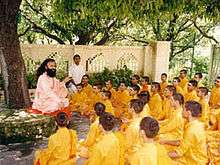Gurukula

Gurukula (Sanskrit: गुरुकुल) is a type of residential school in India with pupils (shishya) living near the guru, often in the same house.[1][2] Before British rule, they served as South Asia's primary educational institution. The guru-shishya tradition (parampara) is a hallowed one in Hinduism and appears in other religious groups in India, such as Jainism, Buddhism and Sikhism. The word gurukula is a contraction of the Sanskrit guru (teacher or master) and kula (extended family).[3][4]
In a gurukula, shishya live together as equals,[5] irrespective of their social standing,[4][5] learn from the guru and help the guru in his day-to-day life, including the carrying out of mundane chores such as washing clothes, cooking, etc. Typically, a guru does not receive any fees from the shishya studying with him. At the end of his studies, a shishya offers the guru dakshina before leaving the gurukula or ashram.[4][5] The gurudakshina is a traditional gesture of acknowledgment, respect and thanks to the guru, which may be monetary, but may also be a special task the teacher wants the student to accomplish.[4][5] While living in a gurukula the students had to be away from home and family completely. The guru did not take any fees and so they had to serve the guru.[4][5]
History
Gurukula have existed since the ancient age. Upanishads mention many gurukula, including that of guru Drona at Gurugram,[3] Yajnavalkya, Varuni. Bhrigu Valli, the famous discourse on Brahman, is mentioned to have taken place in Guru Varuni's gurukula. Vedic school of thought prescribes an initiation (Upanayana, a compulsory Sanskara or activity for a Hindu living) to all individuals before the age of 8 or latest by 12. From initiation until the age of 25 all individuals are prescribed to be students and to remain unmarried.
The gurukula were supported by public donation. This was followed by the many following Vedic thoughts making gurukula one of the earliest forms of public school offices.[3][4]
Modern Gurukul System
By the colonial era the gurukula system was declining in India. Dayananda Saraswati - the founder of Arya Samaj and his follower Swami Shraddhanand were the pioneer of the modern gurukul system, Swami Shraddhanand founded Gurukula Kangri Vishwavidyalaya on March 4, 1902. Arya Samaj's The Dayand Anglo-Vedic education system is a non-governmental educational organisation in India that runs several gurukuls as well as 900+ schools,[6] 75+ colleges and a university.
In 1948, Shastriji Maharaj Dharamjivan das Swami followed suit and initiated first Swaminarayan Gurukul in Rajkot in Gujarat state of India.
Recently several gurukula have begun, driven by a desire to uphold tradition. An example of these new schools include the Ananda Marga Gurukula. Another examples of gurukuls in India are Gurukul Kishangarh Ghasera, Gurukul Kaalba, etc. Yoga Guru Baba Ramdev had studied in Gurukul Kaalba. Sri Sathya Sai Institute of Higher Learning, Puttaparthi, follows the gurukula system.[7]
See also
- Education in India
- History of education in the Indian subcontinent
- Gurukul Kangri Vishwavidyalaya
- Uchi-deshi, similar system in Japan
References
- ↑ "GURUKULS AT A GLANCE" by S.P.Arya (Founder of ARYA BROTHERS CARE) and WWW.GURUKULSWORLD.COM as well as WWW.ARYABROTHERS.COM
- ↑ Yin Cheong Cheng; Kwok Tung Tsui; King Wai Chow; Magdalena Mo Ching Mok, eds. (2002). Subject Teaching and Teacher Education in the New Century: Research and Innovation. Springer. p. 194. ISBN 962-949-060-9.
- 1 2 3 True story behind Gurugram
- 1 2 3 4 5 6 www.academia.edu - Gurukula: A Family with Difference - An Exposition of the Ancient Indian System of Education
- 1 2 3 4 5 American International Journal of Research in Humanities, Arts and Social Sciences: Comparative study of ancient gurukul system and the new trend of guru-shishya parampara, ISSN (Online): 2328-3696, ISSN (CD-ROM): 2328-3688
- ↑ DAV University
- ↑ "दैनिक ट्रिब्यून » News » जींद के कालवा स्थित गुरुकुल में बसी हैं बाबा रामदेव की यादें". dainiktribuneonline.com. Retrieved 2015-05-04.